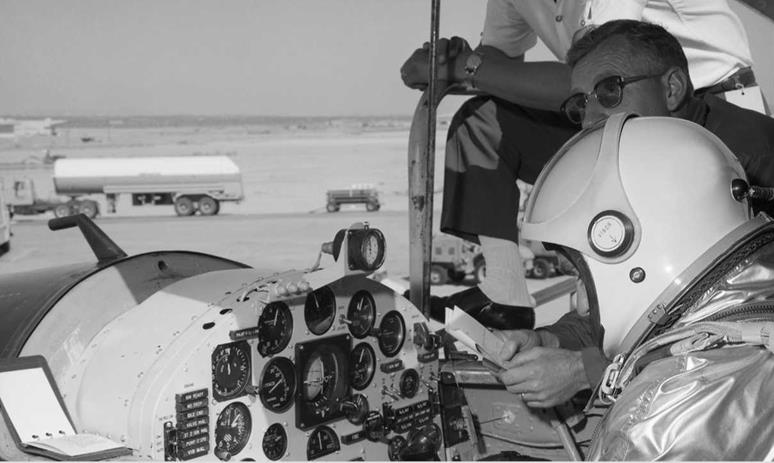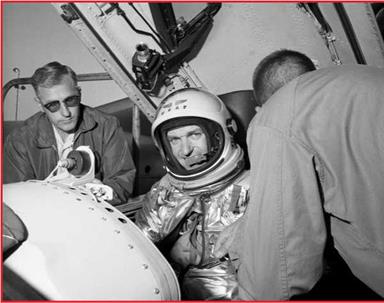JOE HENRY ENGLE
1932-
Joe Engle is the only test pilot who has flown the two-winged vehicles to go into space, the X-15 and the Space Shuttle. He completed sixteen flights in the X-15 program before being chosen for the NASA astronaut program. His X-15 familiarization flight was on October 7,
1963. In a display of exuberance, at the end of this flight he slow-rolled the X-15 through 360 degrees, shocking the engineers in the control room who thought Engle had a control problem. He was thoroughly chastised by chief pilot Bob Rushworth. In the words of Milt Thompson, who was to be the next X-15 pilot, “Joe went on to
become a straight arrow after the flight.” Indeed, in the eyes of Milt Thompson, Engle was one of the better X-15 pilots.


Joe Engle was born in Abilene, Kansas, on August 26, 1932. He graduated from the University of Kansas at Lawrence in 1955 with a bachelor’s degree in aeronautical engineering. After a brief stint as a flight-test engineer for Cessna Aircraft, he was commissioned through the Air Force ROTC program, earning his pilot’s wings in 1958 and going on to fly F-100s. At that time, Engle had numerous opportunities to fly with then Lt. Col. Chuck Yeager, who in turn recommended Engle for admission to the Air Force Test Pilot School at Edwards. Graduating from the Test Pilot School in 1962, and getting a further recommendation from Yeager as “one of the sharpest pilots we had in the program,” Engle went on to the new Aerospace Research

Engle in the X-15 cockpit with a view of the instrument panel. It’s his first flight in the X-15 (October 7, 1963). USAF, Air Force Flight Test Center History Office, Edwards Air Force Base


Engle standing beside the X-15. USAF, Air Force Flight Test Center History Office, Edwards Air Force Base
Engle in the X-15 cockpit for his first flight. USAF, Air Force Flight Test Center History Office, Edwards Air Force Base
Pilot School, also at Edwards. The purpose of that school was to train military pilots to be astronauts.
Graduating in 1963, Engle was selected as a project pilot for the X-15 program. After his first X-15 flight in October, he went on to achieve Mach 5.71 on February 2, 1965. Typical of the maturing X-15 research program, on this flight Engle tested a Martin 255 ablative material on the ventral and nose panels, made skin friction measurements, checked out a nose gear modification, and took boundary layer noise data. On June 29, 1965, he reached 280,600 feet, qualifying him for an astronaut rating. His last flight in the X-15 was on October 14, 1965, which was also his third flight above an altitude of 50 miles.
In 1966, Engle was selected for the NASA astronaut program. He was thirty-two years of age, the youngest man to become an astronaut.
He was also the only person in the program to have flown in space, by virtue of his X-15 experience. First assigned to the Apollo program, he was on the support crew for the Apollo 10 before becoming the backup lunar module pilot for Apollo 14.
Since the Apollo program was coming to an end, he moved to the Space Shuttle program. In 1977, he was commander of one of the two crews that conducted atmospheric approach and landing tests with the Space Shuttle Enterprise. In November 1981, he commanded the second flight of the Space Shuttle Columbia (STS-2), during which he intentionally flew manually large portions of the reentry flight path, performing twenty-nine flight – test maneuvers from Mach 25 through landing.
This was the first and only time a winged spacecraft has been manually flown from orbit to landing.
His last flight into space was as commander of the Space Shuttle Discovery (STS-27) in August 1985.
Engle retired from the Air Force as a major general on November 30, 1986. He went on to participate in the Challenger disaster investigation in 1986 and consulted for the shuttle program into the 1990s. He is enjoying his retirement as an aerospace and sporting goods consultant.
One of the more important aspects of the X-15 program was the providing of technical data for the design of the Space Shuttle. Joe Engel was the human link between the two programs, and he represents the rather smooth transition from the X-15 to the success of the Space Shuttle.










